#also Pygmy cory and guppy
Text



Glorious Gustifer, the Green Dragon Bristlenose pleco
#tank life#plecostomus#bristlenose pleco#Green Dragon#long finned#photozoi#original photos#4-2024#30 gallon#also Pygmy cory and guppy
63 notes
·
View notes
Note
hi mod! you are the person i know who knows and is most excited about fish, and my favorite way to learn is to ask people whose passion and delight i am already familiar with. i know this is stuff i could find digging around on yt or search engines but it is just less fun and often less informative. but ofc feel free not to answer if you don't have the time/energy etc!
i am coming to realize that i would really like fish (after attempting to convince my wife that he would like them and then they pointed out that it kind of sounded like *i* wanted the fish and well). but i am very chronically ill (spend most of my time laying down in bed) and also poor. i'm worried about not being able to take care of them well enough.
assuming i restrain myself (that is don't deep dive into habitat design or breeding or anything beyond just having some guys to spend time with while i'm stuck in bed) what are the daily, weekly, monthly things i'd have to make sure got taken care of? are there ways i can simplify or automate tasks while not sacrificing their care?
OR do you know of good places where people have already talked about this, or other people who love fish a lot and might wanna share their knowledge?
my partner is also suggesting a plant&snail tank instead of fish but i'm even less sure how to approach their care needs!
watching you get into fish reminded me of how much i love them (had some when i was young but was not primary caretaker). it's good to see you make creatures so happy.
well thank you for reading and i hope you are having a good weekend!
ahhh weeee haha fish ask fish ask
there's definitely ways to make mega low maintenance tanks! what you're going for is overfiltering, understocking, and planting as much as possible. I'll go over those points. this got mega long so i'll put it under a cut.
overfiltering basically means bumping your filter up a size. if you have a 10g tank, get a 20g filter. this will reduce how often you need to maintain that filter. I'd recommend sponge filters, they're by far the cheapest option and imo easiest to maintain. you'll need the sponge and an air pump. i see a lot of mega reduced amazon sales for the tetra whisper air pump. depending on how dirty it gets you're looking at every 2-3 months taking it out into a bucket of clean tank water and squeezing out the gunk.
in that vein, you wanna get as big a tank as you can. seems counterintuitive, but the more water you have, the more stability. the less maintenance. so if you wanted a 5g for a betta, consider getting a 10g. if you want a little 10g nano school, get a 20g long. if you want a 20g community, get a 40g breeder. whatever's gonna fit in your space. my best recommendation for tank size is 20g long, it gives you sooo many options without being massive. if you're in America the cheapest way to get a tank is wait for Petco to have their quarterly tank sale. otherwise look for something on the local market.
now onto understocking. basically pick animals that aren't gonna shit that much lol, and put in less than can technically fit in the tank. the snail tank is a definite fun option, as long as you're sticking with pest snails and fewer large snails (big snails have a big bioload, even bigger than most fish). a planted 10g with a variety of big snails (a mystery, a rabbit, a nerite, etc), pest snails, and a few amano shrimp, would be fun and extremely low maintenance. you'd even have the option of trying some fancy shrimp, tho they might breed like crazy. if you want a tank with fish instead, i recommend getting a school of a tiny species like chili rasbora, ember tetras, pygmy corys, basically anything that stays little so you can get as many as possible without a big bioload. for schooling/shoaling fish, the more the merrier. absolutely do not get live bearers. no guppies, no mollies, no platys. that's the opposite of low maintenance. shit machines that will multiply forever, don't do it.
now. you know i love my bettas, favorite fish, but i'm always hesitant to recommend them. they're wonderfully personable but the caveat is that it seems more and more they run into health problems as they get commercially overbred. it's luck of the draw. you might get an easy buddy who can survive anything, or you'll get a sicky. most of the time my bettas are super low maintenance and rewarding, but when they ARE sick, it's hard. it can be daily water changes and treatment for weeks, and sometimes even that doesn't help in the end.
so with that said, my dream low maintenance tank stocking would be 20g long with 4 amano shrimp, 1 mystery snail, 1 rabbit snail, 1 nerite snail, and a school of around 15 nano fish (I'd do either chili rasbora or celestial pearl danio cuz they prettyyy). OR i'd just have a centerpiece in that big old tank, like 1 betta for the whole tank or a pair of sparkling gouramis. fish choice is definitely too much to get into for this post lol.
now third point, planting the crap out of it. this is where things can get expensive. i really do recommend investing in this step at setup, but try to cut costs by buying from local sellers, or even seeing if people are giving cuttings away. the lowest maintenance plants are ones that don't require trimming, like crypts, buce, anubias; these plants are gorgeous but they don't filter water that well. faster growing stem plants and floaters will REALLY help to filter the water, but require more maintenance via trimming and replanting stems (monthly) or removing overgrown floaters (weekly). hornwort and guppy grass are great options for something fast growing that you can just chuck in a tank, no need to plant. what I'd most highly recommend for the sake of lowering maintenance is adding some pothos cuttings coming out of the water. terrestrial plants are much better at filtering water than aquatic plants because of their direct co2 exposure, and I've had the most success with pothos! i also love a spider plant in water.
some other money specific points. for substrate, you can use rinsed play sand and/or pea gravel from a hardware store, but you would need to add nutrients if you have things planted into the substrate. you can add root tabs (api root tabs cost about 8 bucks a pack, but you need to replenish them every few months) or a small layer of aquasoil at the bottom. (aqueon has a little bag of shrimp/plant soil on amazon for i think 12 bucks). and the one thing you shouldn't go cheap on is the heater. their failure is more dangerous than other hardware because they tend to fail ON, aka they cook the water. you wanna make sure you trust it. the cheapest heater i trust are the aqueon preset submersible heaters, also frequently on sale. or you can forgo the heater and commit to only "cold" temperature livestock; the snails and amano shrimp idea would be fine w/o a heater.
labor specific points, once it's cycled (which can take weeks, during which time you'll do literally nothing to the tank) and stocked, it'll depend on how fast those plants eat up your nitrates on how often you do water changes. for me, i do 25% every two weeks on my 20g. it could probably stand to have more since mine is pretty overstocked but fish are ok to sit in slightly higher nitrates as long as they're used to it. when testing, i do recommend the api master test kit. it's more expensive than strips but way more accurate and it's lasted me longer than 2 tubes of strips. if you don't want to buy the test kit, just do water changes as often as you can. every 2 weeks if possible, then you can try pushing to 3 weeks, or even monthly.
get a water siphon to make it as easy as possible. empty water into a bucket on wheels so nobody has to carry anything. you can also look into getting a submersible pump with a long enough tube that you can empty water directly into the nearest drain, then to refill with clean water put a bucket in the sink with tap water, put the submersible pump in that bucket, and run the tube back to your tank, adding dechlorinator directly to the tank beforehand. just be careful with this method if you have small animals at risk of being caught in the siphon.
also, some people with planted tanks don't do water changes AT ALL. they just top off as water evaporates. what i do some would consider overkill, but i'm so frequent with my water changes because i have really hard water and there's this thing called old tank syndrome that can happen if you only top off, and yeah that's this other whole spiel lmao BUT not doing water changes IS possible, people have success. just not me!
so monthly tasks; rinsing sponge filter every 2-3 months. weekly tasks; depends on how often you decide to do water changes. daily tasks; feeding, frequency varies depending on livestock, but i basically feed once a day. if you're going for a self contained ecosystem low maintenance dealio, feed as little as possible. i know of people who do this and sprinkle in food weekly or less. i don't have experience with automatic feeders, but i'm wary of them lol, they could be totally fine, idk. it's better imo to just feed infrequently than risk the auto feeder dumping too much food.
to wrap it up, i'll be real with you, setting up something that's as low maintenance as possible while working with budget constraints is hard (at least in my area). this hobby is notoriously expensive, especially when you're just starting out. you need to see what the local market is like. see if there's fish hobby groups in your area that can help you with spare supplies and plant trimmings. your partner's idea of a plant/snail tank might be the best place to start! as far as other resources, the fish subreddits have soooooooooooo much info.
25 notes
·
View notes
Note
What would be some good tankmates for a thick-lipped gourami in a 40 gallon? My first thought was cherry barbs, khuli loaches and a school of some kind of tetra or guppies, but is there anything else I could consider? And do these stocking ideas even seem feasible?
Love thick lipped gouramis, a fantastic choice. At 75 to 77 F, most non-pygmy corydoras species will work, as do peaceful tetras (Pristellas, Penguins, some pencilfish, hatchets, and maybe Black Neons). I might consider kribensis or Glassfish too. Really, most small peaceful fish that don't need super hard water or cool water will work here. If you keep your water around 77 to 80, consider Cardinals and Sterbai Cory Cats.
I might also consider some smaller rainbowfish like dwarf rainbows and celebes rainbows. Maybe some larger blue eyes. But only if you have slightly hard water.
Any fish in particular you interested in?
2 notes
·
View notes
Photo
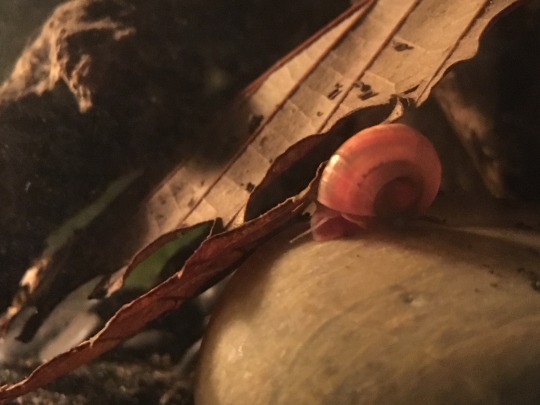



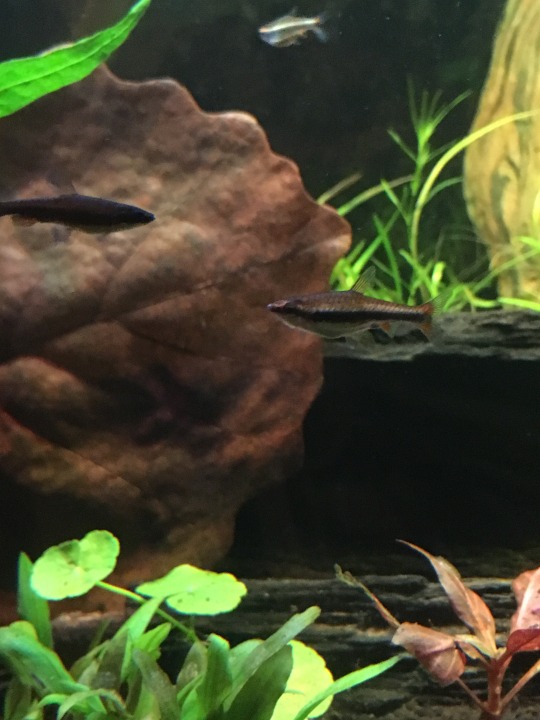

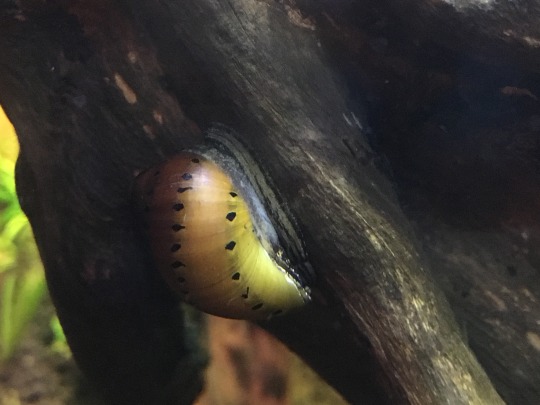
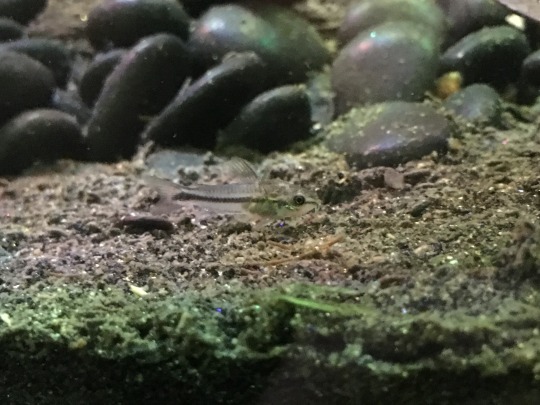
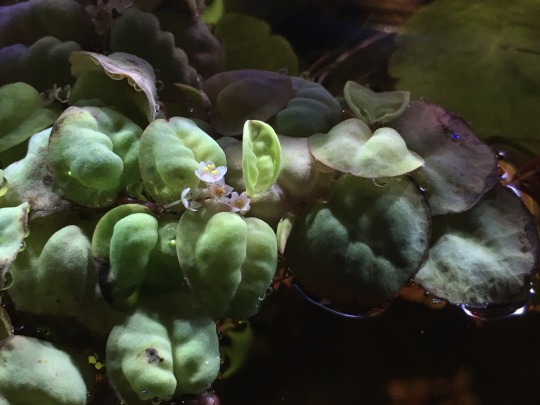
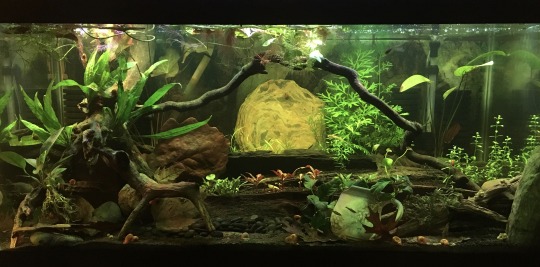
More pics of the 40g! (brought to you by my cellphone rip)
Now with 14 beckford’s red pencil fish, 7 pygmy cory cats, one chocolate whiptail cat, and a pair of macmasteri dwarf cichlids (+ one guppy i cant catch, oi). Also added some red root floater, which has lil white flowers awwwww... Everyone is still baby, but there’s pencil fish sparing and cichlid flirting happening already. I expected the cichlids to get a bit bigger before they matured, but the female is already putting on some bulk so maybe not. Can’t wait to see how it all fills in!
#tried my best on the cory pics but they are so. small.#cichlids aren’t bothering them at all tho!#whiptail not pictured bc they like to snooze in the day time#aquarium#Aquaria#aquascape#planted aquarium#Aquatic Plants#aquablr#tanks#planted fish tank#tankblr#fish#fishblr#plants#floating plants#red root floater#dwarf cichlids#macmasteri#cichlids#pencil fish#pygmy cory catfish#nerite snail#red ramshorn snail#natural aquarium#leaf litter#tannins#blackwater#need to add some more actually...#pets
13 notes
·
View notes
Text
I have an aquarium plan for next year!
I’ve always, ALWAYS wanted a Betta fish... but not in one of those tiddly little ‘display purposes’ tanks... I’ve got a 30 gallon on my wish list, may go bigger ;)
I’m looking at creating a planted tank: plastic plants aren’t known for being great for flowy fancy fins and also live just have that better feel. So I’m thinking of getting some nice ‘hiding’ plants in there (and a moss ball or two... or three) and letting the tank run with heating and not too strong filter and just be for the plants for a month.
I’ve then looked at little tank mates that would be nice and not too stressy to live with my future betta - ghost shrimp and kuhli loaches look perfect (I also considered african dwarf frogs but they may eat the ghosts and just no!) so I will then introduce them and care for them to get them established for a month. They say other fish like neon or ember tetras will also be good tank mates but am currently unsure. (May look at feeder guppies or pygmy cory as fishy tank mates).
During ^that^ month I’m going to start looking for a betta. I don’t want it to be the first one in a tank in case that makes him territorial towards any of the other creatures, so putting him in last may be the solution. He will also be able to be introduced into a tank kept steady at the correct sort of requirements for all so hopefully nothing will require adjusting/ironing out by this point.
Hopefully I’ll finally be able to start my dream of betta fish owning this coming January! I’m keeping my fingers crossed!
9 notes
·
View notes
Text
Care Guide for Cory Catfish
Looking for a peaceful beginner fish with tons of personality? Don't look anymore! Cory catfish, or corydoras catfish, is one of the most popular community fish because they are so happy-go-lucky, easy to breed, and helpful as a clean-up crew. In this care guide, we answer some of the most frequently asked questions about this adorable downstairs resident.
What are Corydoras?
The genus South American catfish has over 160 species. There are several hundred more species that need to be classified. Aquarium hobbies are named after the bony plates of armor on their bodies, 1 to 3 inches long. For protection from predators, these tiny catfish also have sharp hooks in their fins that can sometimes produce a mild venom when stressed (in other words, don't try to catch them with your bare hands).
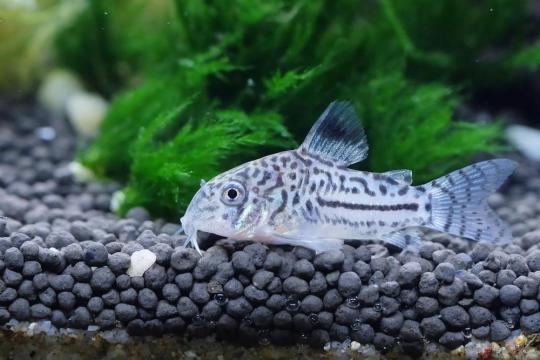
Depending on the species, most cory catfish enjoy temperatures between 72 and 82 °F. For example, the peppered cory catfish (Corydoras paleatus) and the Julii cory catfish (Corydoras Julii) are found on the colder end of the spectrum, while the starbase cory catfish (Corydoras sterbai) can live in higher temperatures. They also prefer a pH level of 6.5 to 7.8.
In the wild, corydoras have been observed in large groups of 20 to hundreds of similar species. They are most active during the day, with peak activity at dawn and dusk. The most popular varieties in the pet trade include the bronze cory and albino cory (Corydoras aeneus), the panda cory (Corydoras panda), the emerald green cory (Corydoras splendens), and the pygmy cory (Corydoras pygmaeus).
What Size Tank Do Cory Catfish Need?
A 10-gallon aquarium is suitable for dwarf species. However, we recommend at least 20 gallons for all other varieties. As relatively small fish, they crave protection in numbers, so a group of six corydoras or more (all of the same species) is highly suggested. These peaceful lowland dwellers can be kept with any community fish that will not eat or attack them. (For example, don't keep corydoras with goldfish, which get quite large and ingest whatever fits in their mouths.)
A 20-gallon aquarium is a great place to stock fish. It can house a school or cory catfish at the bottom, small tetras in the middle layer and a central fish like a honey gourami. A small ecosystem can be created in your living space with the addition of lush aquarium plants.
Can You Breed Cory Catfish in Aquarium?
Yes, many fish keepers discover that corydoras reproduce randomly without much effort. The male's profile is narrow and slim, and the female is large and round enough to hold all the eggs. You can condition them or prepare them for breeding by giving them lots of nutritious food, such as frozen bloodworms and live blackworms. You can also induce spawning by applying cooler than normal water (by a few degrees) during water changes to mimic the rainy season. Soon, you'll find sticky round eggs on the walls and decorations of your tank.
If you want to breed catfish in the same tank they live in, it helps to provide plenty of covers -- such as a dense mass of java fern or guppy grass -- and remove other species of fish. All fish (including the parents themselves) will happily eat the eggs when given the opportunity. For a higher survival rate, you can remove the eggs to raise the fry in a separate aquarium. Feed baby catfish plenty of live baby brine shrimp and powder fry food, put them over water changes, and enjoy a whole new generation of corydoras.
Good luck with your new Corey Catfish!
For more information visit our website Creature Companion
0 notes
Text
HOW MANY FISHES FOR 40 GALLON AQUARIUM?
You can keep a considerable variety of fishes in your 40 gallon tank. a selection of fishes can be placed in the container while taking care that none often tends to damages others. The character and the dimension of the fishes after full growth need to be purely kept in consideration as well as thus investigated for. This ensures that your aquarium has a calm and comfy ecosystem. Around 25 fishes can be placed in a 40 gallon container provided there dimensions reverberate with the shape and size of the storage tank. The suggestion of choosing fishes according to different zones of the container can also be embraced to introduce more range in the aquarium. This storage tank does not keep the number of fishes limited.
WHAT ALL FISHES CAN YOUR 40-GALLON TANK BEHOLD?
As specified earlier, the number of fishes that a 40 gallon container can see is rather high and also hence the tank allows you to create impressive mixes through proper equipping. The fishes to be selected for the container needs to work and should have manageable character. It is not an extremely tough task to make a 40 gallon container colorful as well as brilliant with a combination of elegant and intense plants and animals.
Several of the fishes that container can easily embrace are:
Discus
German Blue Ram
Gourami
Diamond Neon Tetra
Endler's Livebearer
Killifish
Boeseman's Rainbowfish
Faintail Guppy
Cherry Barb
Zebra Danio
Betta Fish
Mollies
Swordtails
Golden Plecos
Glowing Barb
Tiger barbs
Betta fish
Yellow Lab Cichlids
While all these fishes can locate a comfy environment in 40 gallon container, treatment needs to be taken relating to the satisfaction of their needs. Tools like heaters, filters, etc. need to be mounted in storage tank in order to make the setting of the fish tank ideal for certain sorts of fishes.
SOME STOCKING IDEAS THAT CAN COME IN HANDY
The significance of stocking suggestions can not be disregarded. The manner in which you equip your container figures out how successful your leisure activity of fish keeping will certainly show to be. The aqua-habitat that you plan to develop must be tranquil for all the animals. You should permit them to grow without needing to encounter any type of risk from other passengers of the storage tank.
Suitable equipping can be done just after determining the dimension as well as character of the fishes you intend to choose.
Some of the equipping concepts that can be thought about for your 40 gallon tank are:
20 neon tetras, 2 Bolivian Rams and also some Sterbai corys
10 cardinals, 10 rummynoses as well as 10 penguin tetras
10 rummies, 5 dwarf Neon rainbows, 1 Pygmy rainbow, 3 Pearl Gourami, 2 Dwarf patricola, 3 Panda Garra and also 4 black Neon tetras and also for the bottom residents you can select 5-8 Panda Corys or 3-5 Panda Garras
4 grouped or thick lipped Gourami, 2 Bolivian Rams, 8 Zebra danio, 8 Buenos Aires Tetra, 10 Panda or Peperred Corys orKuhli Loaches as well as 1 BN pleco.
3 angelfish, 20 neon tetra, 8 sterbai corydora, 1 BN Pleco as well as 10 Red Cherry Barbs
Several of the considerations for the storage tank:
Do not maintain those fishes with each other which trigger the situation in which the bigger fishes wind up eating the small ones.
Attempt keeping only semi-aggressive fishes to ensure that n damage is triggered to the total ecosystem as a result of the unsuitable personality of some fishes.
If you plan to maintain schooling fishes, keep them in a group of 10-15 so that can prosper while rejoicing and also safe in the container.
Conclusion
Hence, you can do marvels with a 40 gallon tank given you do optimal research about the fishes you mean to maintain and also bring out fantastic stocking concepts which not only look after the variety had by your fish tank however also its life.
soure : https://champagnereef.com/40-gallon-aquarium/
1 note
·
View note
Photo
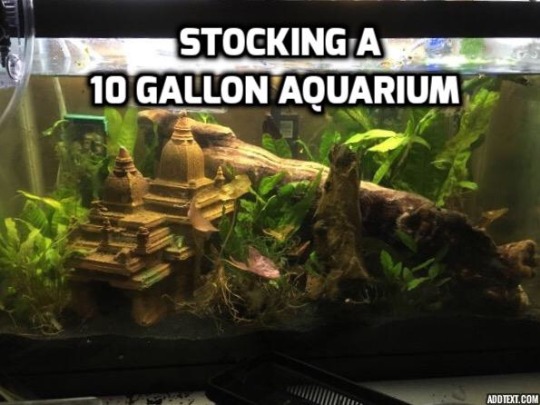
The 10 gallon aquarium is one of the most common aquarium sizes. Its also usually what the beginner aquarist starts with. The 10 gallon poses its own set of challenges because it is such a small volume of water, but that does not mean it is not a viable tank to create a beautiful aquatic ecosystem. This is a list of fairly hardy species that could live in a 10 gallon aquarium. This list also includes some that you can make your own decisions as well about adding to your new aquarium. There are also some “biotope” ideas at the end of this guide to give some ideas.
Sources: Personal experience, 101 Best Freshwater Nano Species by Rachel O'Leary and Mark Denaro, and Anders247’s guide on Fishlore.com.
Betta spp.
• Betta Splendens (1 per tank)
• Betta coccina
• Betta channoides
• Betta albimarginata
Gourami
• Samurai Chocolate Gourami (Sphaerichtys vaillanti)
• Honey Gourami (Trichogaster chuna)
• Sparkling Gourami (Trichopsis pumila)
Catfish
• Asian Hillstream Catfish (Akysis Vespa)
• South American Bumblebee Catfish (Microglanis ihering)
• Habrosus (Corydoras habrosus)
• Pygmy Cory (Corydoras pygmaeus)
• Dwarf Moth Catfish (Hara jerdoni)
Loaches
• Rosy Loach (Petruichthyd sp. “Rosy”)
Tetras
• Ruby Tetra (Axelrodis riesei)
• Ember Tetra (Hyphessobrycon amandae)
Rasboras
• Microrasbora (Boraras spp.)
• Emerald Dwarf Rasbora (Danio Erythromicron)
• Lambchop Rasbora (Trigonostigma espei)
• Dwarf Scissortail Rasbora (Rasbosoma spilocerca)
• Green Neon Rasbora (Microdevario kubotai)
• Blue Neon Rasbora (Sundadanio axelrodi)
Danios
• Celestial Pearl Danio (Danio margaritatus)
• Gold Ring Danio (Danio tinwini)
Misc.
• Guppy (Peocilia reticulata)
• Endler’s Livebearer (Procilia wingei)
• Platy (Xiphophorus maculatus)
• Scarlet Badis (dario dario)
• Red Pencilfish (Nannostomus mortenthaleri)
• Dwarf Pencilfish (Nannostomus marginatus)
• Pea Puffer (Carinotetraodon travancoricus)
• Dadio (Laubuca dadiburjori)
• Asian Rummynose (Sawbwa resplendens)
• Sparkling Gem Minnow (Tanichthys micagemmae)
• Lyretail Killifish (Aphyosemiin australe)
• Clown Killifish (Epiplatys annulatus)
• Least Killifish (Heterandria formosa)
• Florida Flagfish (Jordanellr floridae)
• Pygmy Sunfish (Elassoma spp.)
• Norman’s Lampeye (Poropanchax normani)
Inverts
• Shrimp (Caridina sp./Neocaridina)
• Nerite Snails (Neritina spp.)
• Mexican Dwarf Crayfish + Variants (Cambarellus patzcuarensis)
• Assassin Snail (Clea helena)
• African Dwarf Frog (Hymenochirus boettgeri)
==================================================
Tank Ideas
Assuming adequate filtration and live planting
South Anerican Blackwater
6-8 Ruby Tetra
6 Habrosus Cory OR Pygmy Cory
1 Dwarf Crayfish
South American Community
3 Endler's Livebearers
6-8 Ember Tetra
1 South American Bumblebee Catfish
Indian River
1 Honey Gourami
6-8 Dadio
10-12 Green Shrimp or Indian Zebra Shrimp
American Wetlands
PAIR Florida Flagfish OR PAIR Pygmy Sunfish
6-8 Least Killifish
1 Cajun Dwarf Crayfish
203 notes
·
View notes
Text
Betta Tank mate – The most important thing you need to take care your Betta
You love betta but you cannot put multiple Bettas in the same tank. However, did you know betta fish (aka the Siamese fighting fish) can be kept with other fish? If you dont like to watch tank with single betta, keep reading to discover our list of 10 compatible Betta tank mates!
What to Look for In the Best Tank Mates for Betta Fish
Betta Tank Mates
Shortly, we’ll give you a list of some of the best choices for a betta tank mate. But, if you prefer to choose your own, here’s a checklist of characteristics your new fish should have.
Betta Tank Mate Checklist
Qualities to look for include:
Non-aggressive / no fin nibbling
Won’t compete for the same food in the same zone (top, middle, bottom)
Likes water with a pH from 6.0 to 7.5
Likes water temperature between 76F and 81F (24C to 27C)
Middle to top swimmers should be no more than 2-3 inches
Prefers slow-moving water
List Of Fish That Can Live With Bettas (For Those Short On Time)
If you’re short on time then here’s a list of fish that can live with bettas as well as shrimp and snails:
Ember Tetras
Guppies (Under Certain Conditions)
Platies
Harlequin Rasboras
Lambchop Rasboras
Dwarf Rasboras
Pygmy Corys
Bronze (Common) Corys
Endlers Livebearers
Chili/Mosquito Rasbora
Dwarf Loach
Zebra Danios
Rummy Nose Tetras
Cardinal Tetras
Neon Tetras
Black Neon Tetras
Mollies
Scissortail Rasboras
Otocinclus Catfish
Redtail Sharks
Glass Catfish
Malaysian Trumpet Snails
Ramshorn Snails
Mystery Snails
Nerite Snails
Ghost Shrimp
Cherry Shrimp
Dwarf Crayfish
Assassin Snails
Amano Shrimp
Do Betta Fish Need Tank Mates?
Before getting tank mates for your betta you may be wondering whether it’s necessary? You may even be asking whether tank mates will make him happy. Well, the answer is a little more complicated than a simple yes or no.
On the one hand, some bettas are too aggressive to be put with other tank mates (unless you’re using a large enough tank with plenty of hiding spaces) so it’s better to keep them on their own.
On the other hand, bettas need stimulation to stop them from getting bored and even depressed. While using mirrors, adding lots of plants, hiding places and spots to explore in your tank can help stimulate your betta, there’s no denying that other tank mates in your tank are going to be a constant source of entertainment.
However, just remember, that to keep your betta happy you need to make sure he has enough space in the tank he can call his own territory. So when adding tank mates with your betta it’s important that you use a tank that’s big enough.
Can You Keep 2 or More Bettas Together?
The answer to this question is no. And yes. I’ll explain.
Yes, you can put two or more betta fish together, but you must follow some rules to prevent not only duels-to-the-death but the more common bullying.
But no! Don’t put two males together. They will fight until one is dead.
Male & Male
Don’t put two males together. They will fight until one is dead. If this is your idea of entertainment, please leave the fish-keeping hobby. Don’t do this combination!
Female & Female
You can put two or more females together, but this is something that must be done cautiously. If you put more than two females together, then you must introduce the same number at the same time. If you want to have three females, you must introduce them all at the same time. If you add 1 + 2, then there will be bullying of the one. Consider these possibilities:
1 + 1
1 + 1 + 1
2 + 2
Anything other than 1 + 1 requires a tank that is already “cycled” to accept a load of three fish. If you have no filtration system, then a tank with three female bettas would require a 30 gallon tank. (A heater, a lid, and a few other common aquarium items would still be necessary). Don’t combine 1 + 2 female bettas.
Male & Female
You can put a single male and single female together without fighting. It’s the breeding that would ensue eventually that would overwhelm your skills as a beginner aquarist. Don’t do this combination unless you’ve had a couple of years of success with keeping an aquarium. And don’t breed bettas if you haven’t read extensively about the needs of the pair and their offspring. Breeding is not for beginners or people who think it would “be fun” to breed them. Don’t do the male + female (breeding) combination until you have experience.
Will Your Betta Attack His/Her Tank Mates?
Once again, there’s no way to know until you add tank mates into your tank. If you’re not sure it’s often a good idea to add tank mates you won’t mind losing such as shrimp. The good news is that if you add some cheap shrimp then even if your betta does kill them they’ll become a nice meal for him!
But the truth is you can never tell how your betta is going to be with tank mates until you give it a try. But as long as you’re giving them enough space, then in a lot of cases, it’s going to work out just fine.
Remember
Before you do plan on adding tanks mates for your betta you should always have a backup plan just in case. Normally people have a spare tank they can transfer their betta too if things go south. However, if your tank is big enough a tank divider is also a great alternative.
The post Betta Tank mate – The most important thing you need to take care your Betta appeared first on Successful Aquarium.
0 notes
Note
Howdy! Do you have an stocking suggestions for a 10-15 gallon tank beyond a betta? Interested in trying out other types of fish but when I see the internet making suggestions like swordtailsand kuhli loaches I don't trust any of the lists I've come sctosd so far.v
Yeah Swordtails are poor choices in this size tank... they are built for speed! They really need at least 29 or 40 gallons.
Other livebearers could work though. Endler's livebearers are a fantastic choice for a 10 gallon tank and I can't recommend them highly enough. Guppies are better in the 15+ gallon range, and Platies will work okay there too (but are honestly better in 20+). Also consider some of the Micropoecilia livebearers like Swamp Guppies and Para Mollies.
Some smaller tetras would work here. Ember and Ruby tetras are small enough for a 10 gallon; Neons, Dwarf Pencilfish, and possibly Glowlights are options in a 15.
There are some smaller catfish worth considering. Asian Stone Catfish are a good choice, as are potentially Driftwood Catfish, in a 10. Pygmy Cory Cats will do fine in a 15. I don't recommend "normal" Cory cats below 20, honestly. They get chunky!
Other groups are also possible - a few that come to mind are ricefish, smaller blue eyes, celestial pearl danios, Dario species, bumblebee gobies, maybe a pair of killifish... it all depends on what sort of water you have though.
Hope that helped a little!
3 notes
·
View notes